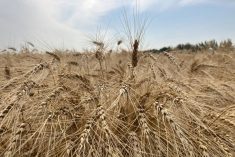MarketsFarm –– A dry spring on the Prairies, coupled with intensely wet weather south of the border, has frustrated producers and supported higher feed grain prices.
Barley prices have rallied “quite strongly” due to dry weather observed across most of the Prairies, combined with tight supplies from previous years, said Nelson Neumann of Agfinity in Edmonton.
Conversely, corn prices have surged due to the prolonged wet weather and flooding conditions across the U.S. Midwest. Experts have forecast about two million fewer tonnes of corn will be produced in 2019, causing corn futures to skyrocket.
Read Also

China to buy 12 million metric tons of soybeans this season, Bessent says
U.S. Treasury Secretary Scott Bessent said on Thursday that China has agreed to buy 12 million metric tons of American soybeans during the current season through January and has committed to buying 25 million tons annually for the next three years as part of a larger trade agreement with Beijing.
Barley is currently hitting prices between $270 and $275 per tonne, and corn is trading between $275 and $280 in Lethbridge.
Feed wheat is also seeing strong prices, riding on barley’s coattails.
Wheat prices are in between $255 and $258 in Lethbridge.
“When that price shoots up, substitute products follow,” said Neumann.
Uncertain weather forecasts have producers waiting to sell, driving prices higher. “It’s a seller’s market,” he said.
“If it stays dry, we could see prices climbing. If we get substantial moisture, prices will correct down.”
Some experts surmised China’s lack of appetite for Canadian canola would result in producers transferring canola acres to barley, but Neumann believes producers are sticking with previously stated planting intentions.
“I’m thinking it might be a decent year for feed grains,” he said.
— Marlo Glass writes for MarketsFarm, a Glacier FarmMedia division specializing in grain and commodity market analysis and reporting.












